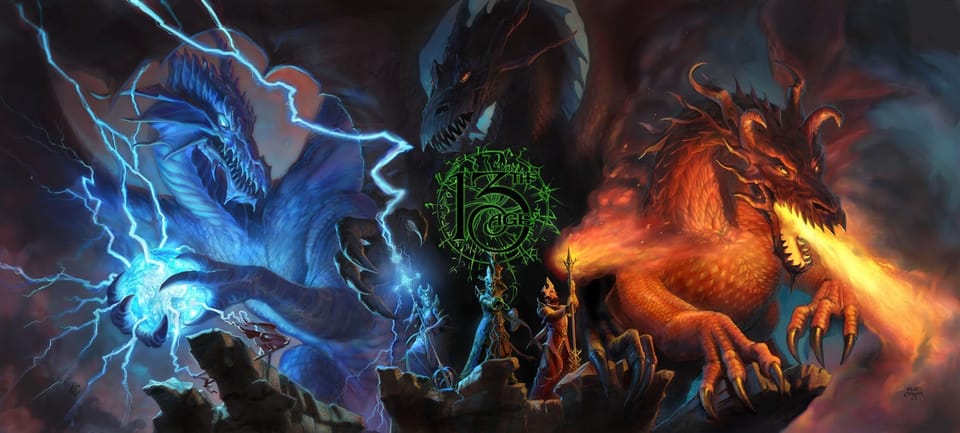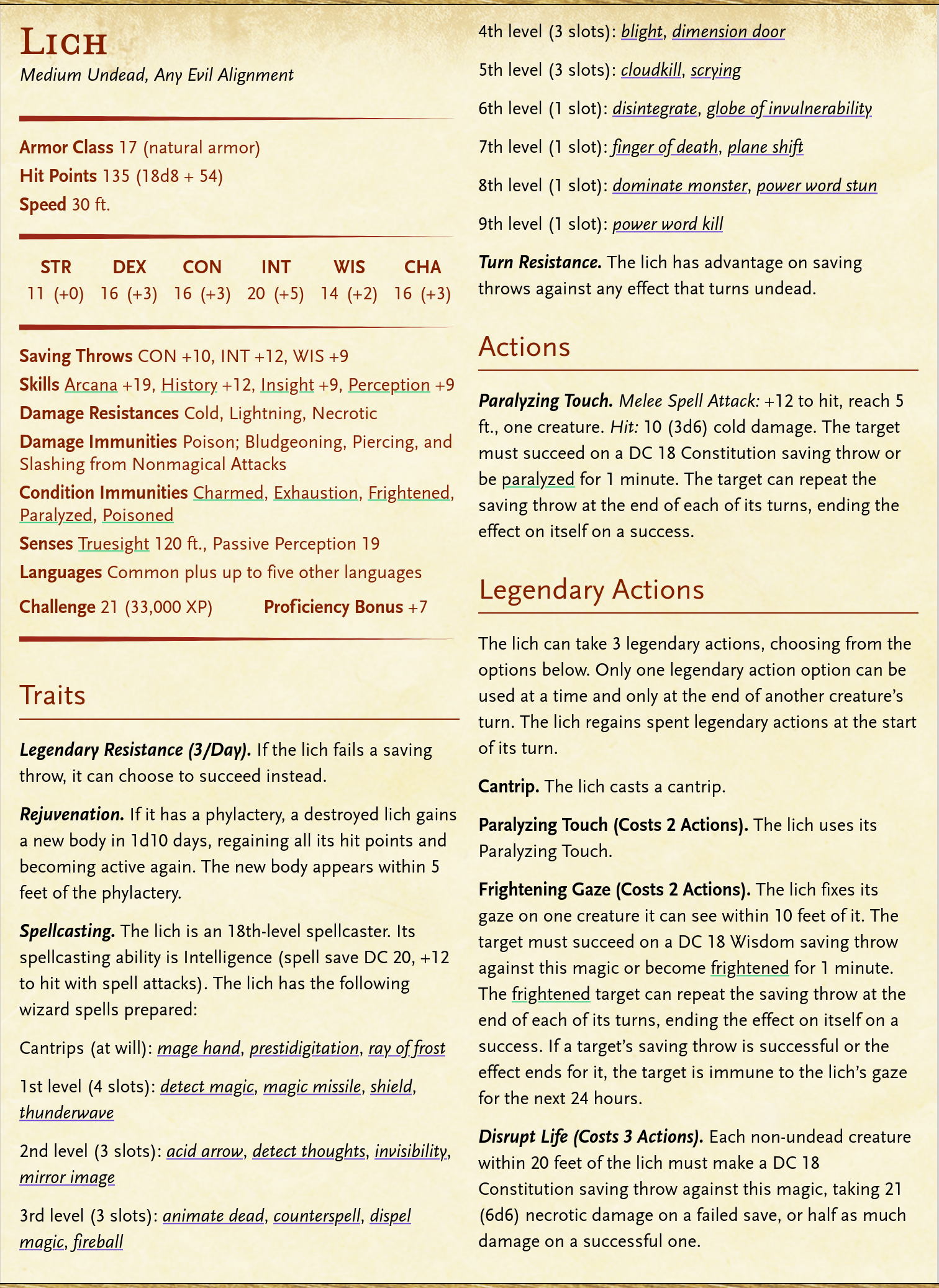Get Inspired: 13th Age

This is the first of many posts where I'll be going over systems that I've played or read and what I enjoy about them. If you already enjoy whatever system you're playing right now, there are lots of things you can copy from these games into yours. If you have the game design itch, these games also have some very interesting systems, mechanics, and other bits that make them really interesting to look at when thinking about making your own.
13th Age is a d20-based game that's quite similar to popular RPGs like Dungeons and Dragons. It was made by Rob Heinsoo and Jonathan Tweet—the lead designers of D&D 4e and D&D 3e, respectively, and you can tell by some of the design in the game. In the introduction of the game it explains what people liked and disliked about 3rd and 4th editions of D&D, and what Rob and Jonathan did to keep the good parts while leaving out the bad parts.
Here are some of my favorite parts of the system not found in many other d20 games.
Backgrounds as Skills
You do not have skills in 13th Age—instead, you have backgrounds. You have a sum of eight points distributed amongst any number of backgrounds, so you can have two backgrounds with four points each or three backgrounds, two of which have three points while the third has two points. In any case, these backgrounds have a name, such as Former captain of the emperor's army, or Bodyguard for the bandit lord Rulf.
Whenever you make a skill check in 13th Age, you state a background you think applies to the skill, and apply the number associated with it as a bonus to your check. For example, let's say the barbarian is sneaking. Their dexterity bonus is a +2. The GM asks for a dexterity check, and the barbarian player says "I think my Big game hunter of the Ravenwood wilds background applies here," and the GM agrees. That background has a +4 bonus. They roll a d20, add their dexterity bonus (+2), and the bonus associated with that background (+4), for a total of a +6 bonus.
I love this system. Players often feel like their backstory is impacting their character in the present. A wary GM may wonder "Can this be abused?" and I don't think it can be, really. As a GM, you have the power to say that a background doesn't apply. I would suggest you do not make liberal use of that power—only use it as a last resort. Instead, I encourage you to give the player the benefit of the doubt and ask how it would apply to the scenario. If their answer leaves you wanting, I suggest having them give a detailed story of how their Birthday clown in the capitol city background would apply to their attempt to win in an arm wrestling match against an ogre.
I think it goes without saying, but players who keep trying to abuse the system should be shut down and given clear explanation why. If you run a session zero, explain that players should be thoughtful with their backgrounds—it will only be beneficial for the entire group to not have 10+ minute long discussions about the relevance of backgrounds during a skill check later on down the road.
Super Easy Monsters
Monsters in 13th Age have some of the most easy stat blocks you can find—period.
This is a holdover from the 4e era—one of the nicest things about D&D 4th Edition was how compact the stat blocks were for monsters. Rob seemed to think it was still a good idea when creating 13th Age because that mindset came back in full force. The simplest monster in any dungeon-delving, dragon-slaying game I can think of is either a skeleton or a goblin. In 13th Age, you can fit several stats of each on an index card, while some systems (looking at you 5e) each of those monsters have so much unnecessary fluff like languages spoken, senses and passive perception, speed, and all six ability scores and mods! Absolutely unnecessary fluff to tell you a simple attack bonus with their dagger/spear/shortsword/scimitar, their AC, and one special thing about them.
That said, not all monster stat blocks in 13th Age are simple—but they are all easy.
The Unprepared Lich Test
I want you to imagine a scenario: Your players have completely gone off whatever path you prepared for this session. You are a good GM and you don't force them into what you prepared, but you are hanging on by the skin of your teeth.
Oh no... they went into the obviously-a-lich tomb that you expected them to not find out about until several sessions from now. The only thing you have prepared is the stat-block printed out in front of you. You pull it out...
We'll now look at two different stat blocks that you might have printed. I want you to think about how much page flipping you'll have to do to run these monsters.
One of them has a list of twenty-six spells that you absolutely do not know the mechanics of, three special actions, and four special features. One of them has access to five languages that you didn't even think about until you read the stat block. One of them has twelve resistances and immunities that you'll be having to remember as your players try to kill this thing. You sure do hope that truesight sense doesn't come into play.
The other has just three actions and three special features. No spell list, no immunities or resistances to remember in heat of the moment.
Which one of these do you feel confident in that you can run as your players roll initiative? Which one looks easiest to run?


Escalation Die
13th Age has enforceable rules and mechanics in the game to ensure the characters feel like heroes. Not many heroic fantasy d20 games can say the same. Not many games have the escalation die.
The escalation die mechanic is extremely simple: Have a huge six-sided die ready. On round one of combat, nothing is out of the ordinary. Round two: put that huge die out on the table with the 1 side up. The heroes (and some monsters like dragons) add whatever that die shows to all attack rolls. Round three: the 2 side is face up, etc etc.
In 13th Age, monsters are actually really tough out of the box—you have to roll a 12 to hit the weakest goblin at level 1 and a 14 to hit almost anything tougher. This is all balanced and intentional because the monster stats are designed around the escalation die increasing each round. That 14 to hit becomes a 12 to hit on round three, and by that time the party already had some pretty good rolls most likely. This ends up with a combat where you start out on the back foot, but in the next few rounds you find momentum and start landing blow after blow. The deadliest spells and powers are used at these high-escalation-die rounds and you defeat the foes that stood before you—because you're heroes, dammit!
Now, if you enjoy more grim/dark/bleak/grittier games, then this is probably something you do not want to take into your game. If you enjoy the heroic high fantasy settings of Golarion or Faerun, though, then this might be something worth taking a look at!
Icons
In 13th Age, the player characters are already connected to the world at level 1. They all start with relationships with the most powerful people/institutions/organizations around—the Icons, in 13th Age terminology. These are not necessarily positive relationships, mind you—they can start off with a deep hatred towards the evil lich that plots against the realm, or the red dragon that just woke up from an ancient slumber and erupted a volcano that destroyed their village when they were young.
Players create their characters with three points to allocate to relationships. They can invest all three points into a single relationship or distribute them as they see fit. Then, when a player deems it useful for them, they can cash in on a relationship and can shape the narrative however they wish, so long as it aligns with whatever relationship they're cashing in on. For example, a player may have a negative relationship with a lich and they face a necromancer who is a follower of the lich. The player notices that the necromancer needs his staff to continue his evil deeds and decides to use their negative lich relationship to have some sort of device that can destroy the staff. This actually happened, by the way—I was that player.
I won't go into the details in how 13th Age makes this mechanic manifest since that's not the interesting part about it, in my opinion. If you were to take this mechanic into your game, I would just have it so each player starts with a token for each point they have—so three tokens each. At any point in the session, the player can spend that token by throwing it at the GM and saying how they want the associated relationship to benefit them in the current scene. As a GM, you definitely should be in favor of the player here and be in a much more of a "yes, and" kind of mood.
Range Bands
13th Age is a game that tries to really reduce the unnecessary amount of stuff in our fantasy d20 games, and grids and movement speeds have not been spared from the gaze. One of the biggest criticisms of D&D 4e was that it felt like a minis war game. We can see in 13th Age that Rob probably did not consider the grid or movement a core part of D&D, and replaced it with range bands in 13th Age.
It basically boils down to just three ranges: Engaged, Near, and Far. Engaged means in melee-combat range, Near means within the range of movement, and Far essentially means anything beyond that. Porting this over to your game usually will mean getting rid of movement speed, which is pretty easy to do—please just don't get hung up over trying to simulate a difference between someone with 30ft movement and 35ft movement—just make it all the same.
Conclusion
It only took nearly 2,000 words to describe the many elements from 13th Age you can and absolutely should be putting into your games! The game has so much to offer both GMs and players to make your heroic fantasy d20 games run quickly and easily, while also making the players feel powerful and cool. If you are considering switching from D&D 5e to a similar game, I highly encourage you to take a hard look at 13th Age. Friend of the blog, Into the Fray, has written a blog post, A 5e Player's Guide to 13th Age, which will help transition your players over!